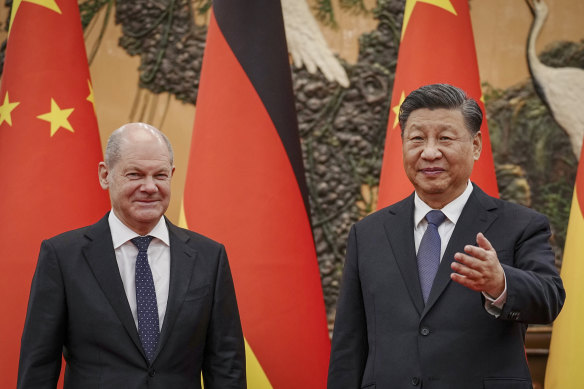
What might be regarded as the dumping of cheap goods in export markets is producing a strengthening backlash from China’s trading partners.
It was the key topic discussed when US Treasury secretary Janet Yellen visited China last week and was followed up by a US trade delegation, which met with its Chinese counterparts in Washington this week. The Treasury said it had continued to express concern about “China’s non-market practices and industrial overcapacity”. Yellen has said “nothing is off the table” in responding to China’s overcapacity.

German Chancellor Olaf Scholz has put Chinese President Xi Jinping on notice for potential tariffs.Credit: AP
German Chancellor Olaf Scholz, visiting China this week, also called for China to reduce its industrial overcapacity and open up its domestic markets.
The leader of the European country with the strongest and deepest economic relationship with China warned that unless the trade imbalance in the relationship (a European Union deficit of €291 billion, or $480 billion, last year) were addressed, China would inevitably face tariffs in Europe.
The European Commission is already investigating Chinese subsidies and domestic protections for electric vehicles, medical devices, solar panels and wind turbines and is threatening to impose tariffs on them. The Commission says it will use all the trade tools at its disposal to ensure fair competition.
Loading
It’s not just the Europeans or Americans pushing back against the flood of Chinese exports. The UK, India, Japan, Brazil, Argentina and others have all complained about the deluge of cheap Chinese goods and have launched investigations into imports from China.
Dumping subsidised goods or products that, because of the excess capacity in China’s factories, are being sold at sub-economic or uneconomic prices into the global market is an unsustainable strategy.
Not only will it intensify the backlash already developing, but it is unsustainable for China’s factory owners, their financiers and ultimately for China’s economy.
The weight of that unproductive overcapacity might already be showing up.
Industrial production was 7 per cent higher in the first two months of the year than for the same months last year. In March, however, it was only up 4.5 per cent. The rate of growth in exports also slipped in March.
Xi Jinping has responded to criticism from the West by telling Germany’s Olaf Scholz that both sides should be wary of the rise of protectionism and look at the issue of production capacity objectively.
“China’s exports of electric vehicles, lithium batteries, photovoltaic products, etc have not only enriched global supply and alleviated global inflation pressure but also made great contributions to the global response to climate change and green and low-carbon transformation,” he said.
All that is true. But the Americans and Europeans are adamant that they aren’t going to allow China to maintain its dominance of green technologies vital to tackling climate change by using unfair trade practices – the barriers to entry to China’s domestic markets and the layers of subsidies for sectors that are prioritised within Beijing’s five-year plans.
Having seen domestic industries wiped out by China’s targeted export strategies in the past (Europe was once the leader in developing and deploying green technologies, and it was Tesla in the US that built the foundations for the electric vehicle industry), they appear determined to do whatever is necessary to prevent that from recurring.
If the safety valve provided by the surge in export volumes starts to close, Beijing will eventually have no option but to do more to stimulate domestic consumption, which is faltering again. Retail sales, for instance, were up 5.5 per cent in the first two months of the year but ended the quarter, a month later, up only 4.7 per cent. March sales were 3.1 per cent higher than in March last year.
At the core of the challenges confronting Chinese policymakers is the depressed property sector, once one of the key drivers of the economy. It continues to shrink, with investment down another 9.5 per cent in the quarter (after falling 9 per cent in January and February), new construction starts down 27.8 per cent, and the amount of floor space sold down 19.4 per cent.
It’s little wonder that Chinese consumers are risk-averse, as much of the wealth of urban households is tied up in property.
Beijing’s planned incentives to encourage the trading of home appliances and automobiles for new products to stimulate consumer activity are unlikely to move the dial of consumer confidence enough to produce a more balanced economy.
More substantial stimulatory measures are needed to finally resolve the issues within the property sector, which, it seems, has been hoping time would come to its aid.
China might meet its target for GDP growth this year. Somehow, it always does. But that growth is now so unbalanced and the pushback from China’s trading partners so strong, that the strategy underpinning it is probably self-defeating. Xi might have to revise his five-year plan.
The Business Briefing newsletter delivers major stories, exclusive coverage and expert opinion. Sign up to get it every weekday morning.



























